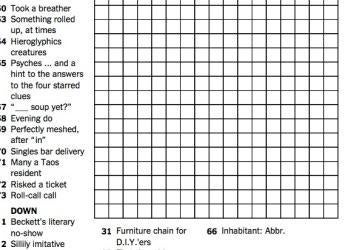This weekend’s New York Times Magazine features a profile of Viola Davis, a much-discussed meditation on “The Death of Adulthood in American Culture,” and a diagramless crossword puzzle by Fred Piscop. Diagramless crosswords, or “diagramlesses,” are blank 17-by-17-square grids that invite you to fill in the intersecting words without giving you the usual diagram provided by black boxes that tell you where the words should and shouldn’t go. Requiring less lexical erudition but more spatial savvy than regular crosswords, diagramlesses are a delightful chance for crossword aficionados to work out a different part of their brains.
But the Times Magazine’s version makes you jump through what I’ve always thought was a strange hoop before you start solving. Like all the Times’ diagramlesses, this week’s comes with a potentially befuddling introductory note: “The first square across is given with last week’s answers.”
What that means, practically, is that you have to flip back through several pages of the magazine to find out where 1 Across begins. The location of the first square is a crucial piece of information, so why does the New York Times Magazine make you go hunting for it, I always wondered, instead of just telling you right there next to the grid?
The answer, I recently learned from a colleague who constructs crossword puzzles, is that advanced puzzlers do the diagramless without knowing the location of the first letter of 1 Across. If the clue were given with the puzzle, it would spoil part of the challenge for these highly skilled puzzlers.
If you’re a diagramless master, this is already glaringly obvious to you. If you’ve never done a diagramless, the idea of doing a crossword when you have no idea where to start writing the first word might seem impossibly masochistic. But it’s not. If, like me, you regularly complete the New York Times Magazine diagramless after looking at the first-square hint, you’re almost certainly ready to do it without looking at the hint. It just requires some extra materials—namely, a sheet of paper (ideally graph paper)—or else you risk erasing and rewriting a lot of letters while figuring out where the answers sit on the grid.
With any diagramless, you can tell how many letters the answer to 1 Across contains by looking at the number of the next clue. (If the second clue is 7 Across, 1 Across has six letters; if the second clue is 4 Across, 1 Across has three letters; etc.) You can also usually figure out the word that goes in 1 Across pretty easily, since diagramless clues tend to be straightforward. If not, see if you know the answer to any of the down clues that intersect with 1 Across. Use the adjacent letters of those down answers to figure out where subsequent across answers fall. This will help you discern whether the second across answer falls in the first row or in the second row. (If it falls in the second row, then you know that 1 Across is surrounded only by black squares on both sides, which is helpful information.) Either way, after solving several clues, you’ll eventually have a line of answers and black squares that’s 17 squares across. Once you get to this point, congratulations—you now know where in the top row the first letter of 1 Across belongs, and you can transfer your answers to the grid provided by the magazine before you continue solving.
If that all sounded like gibberish, I apologize—talking about crossword puzzles is, to steal a phrase, like dancing about architecture. (Those who are still confused can also try this step-by-step guide from eHow.) But don’t let my lack of precision stop you from trying this week’s diagramless without knowing the location of the first square: It’s more intuitive than it sounds. And if you find yourself stumped, you can still go ahead and flip back several pages to that clue that—as I’ve finally discovered—is helpful but not necessary.
